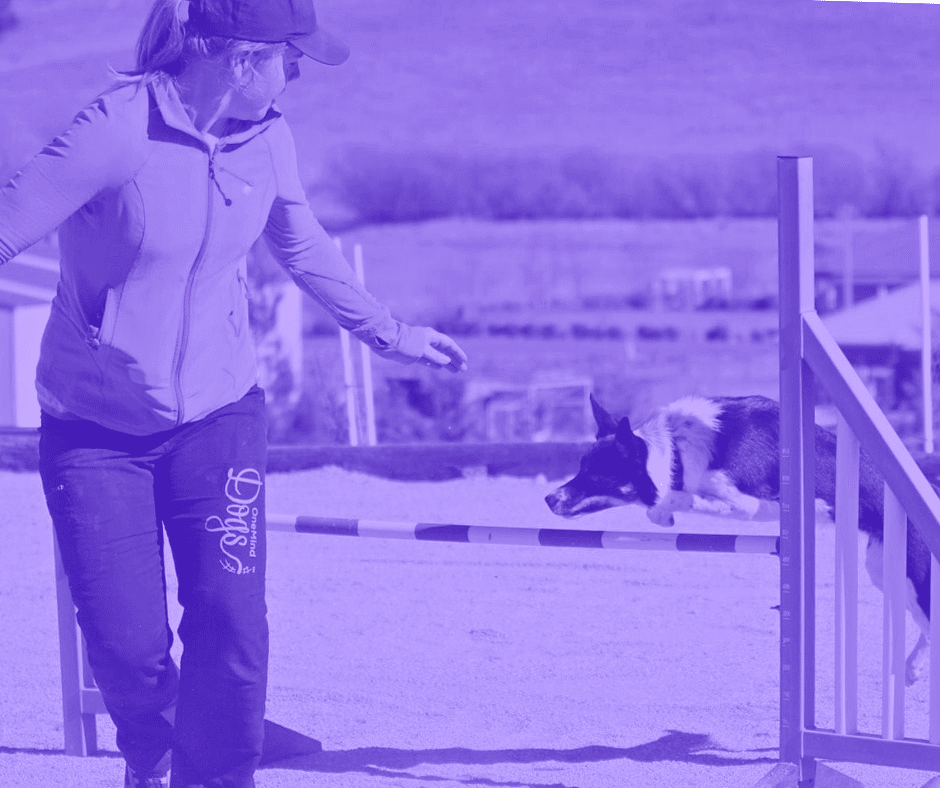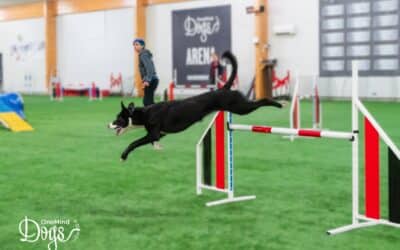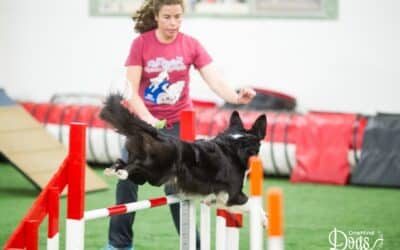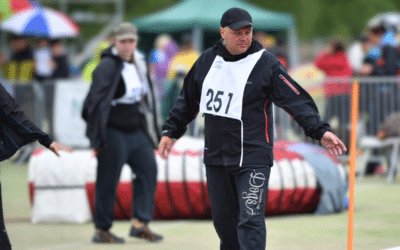I’ve been coaching OneMind Dogs seminars for almost 6 years now and I’ve been competing in agility for two decades. During that time, I’ve had the pleasure of working with all types of students and dogs. At some point, we’ve all had to work through the same question: how do I get more clean runs in agility?
It’s one of the most common topics brought up in agility training. Luckily, it’s one we can work through with some simple changes in your way of thinking. In my experience, five main points come up as the biggest game-changers. We’ll go through them here, and equip you with simple solutions for each one.
Achieving seamless, flowing runs for all types of dogs and handlers is a topic I’m very passionate about. To keep it brief, we’ll discuss the main insights for each point: the issue, why it happens, and how to fix it. You’ll also find a form for my webinar at the end. Signing up gives you access to dedicated discussions on each point, video examples, and course maps to help with practice.
Now, let’s explore the 5 main points that can help you to achieve clean runs, and how you can start working on them today.
1. Connection
At OneMind Dogs, Connection is the cornerstone of the Three Cs: connect, commit, cue. We created the concept of the Three Cs because of how they feed into each other.
Connection is the communication link between you and your dog. Commitment is your dog’s ability to focus on the next obstacle. Cues are the information your dog needs to make adjustments as they flow through the course.
Each one needs to be used in sequence for consistent clean runs. Without connection, you won’t see your dog’s commitment. Without commitment, it’s hard to give cues in–time and with clarity. Note how each one focuses on the dog’s perspective, not the handler’s.
That’s because dogs naturally seek out a connection with their handler. When running a course, one of you is responsible for the connection while the other focuses on the performance. If your attention is on the obstacles, your dog has to look for you instead of focusing on their job. That’s usually when you’ll see dogs flanking obstacles or going off course, for example.
Building a strong connection is about maintaining an awareness of where your dog is and what they are focused on. This doesn’t always mean keeping direct eye contact, most dogs only need to see your side profile to maintain a connection. Once a connection is established, the dog’s eyes are often focused on the next line they plan to take, which helps you predict their next move.
When you work towards a connection, you’ll understand how your dog processes information. This’ll improve reaction time during runs and help you stay in control throughout.
2. Handling for the dog
Your dog needs handling information at different points on a course. When you’re connected to them, you can time your cues in a way that encourages clean runs. But not all instructions are good instructions. Your delivery and timing matter.
Pointing to the next obstacle, for example, is one way to give direction. It tells your dog where to go next. But if that’s all it communicates then the instruction is incomplete.
Your dog goes, “Okay, I need to go towards that next, but what do you want me to do when I get there? Should I jump in extension? Am I collecting? Do I need to turn or carry on straight?”
Proper instructions help your dog prepare for the next part of the course. When you say, “Get ready for a tight turn,” the obstacle doesn’t matter anymore. Your dog knows that they’ll need to turn in a few strides, and they can focus on the approach.
Now, if they need to switch leading legs or change their angle, they have enough time to adjust (more on that below). When you walk a course, don’t think about it as a handler. Process the course as your dog would.
You might think, “Okay, I’m going to do a front cross when I get here.” Ask yourself if it really matters where YOU are (when realistically, the dog could already be in mid-air by that point). Try switching gears and think about where your dog needs the information “when my dog is here, I will tell him that a turn is coming up”, that gives your dog the best chance of safely proceeding and completely changes how you run a course. It’s a subtle mental shift that helps you make better decisions too.
3. Handle lines, not obstacles
Instructions work best when you think about how your dog receives them. The same is true for how they view the course. While it’s tempting to focus on obstacles in an agility ring, ignoring the spaces between them makes it harder to get clean runs.
Think about the imaginary path your dog has to take instead. Handling lines is about guiding them along an optimal path for the best results. Their lines should help them approach at good angles, perform an action comfortably, and progress safely. The speed will follow.
When you think in terms of the lines your dog should take, you can read any course and support your dog from start to finish. Let’s use a hurdle as an example.
If you’re thinking about the obstacle, you’re thinking about the action your dog needs to perform. For a hurdle, you can train a jump to perfection, but it’s not the only thing you need to prepare for. Your dog needs to land in the right direction so they can turn safely, and accelerate as soon as they land.
Handling the obstacle makes it about the jump. Handling lines makes it about shaping your dog’s approach so they can do it seamlessly and exit correctly.
The right lines make it obvious where your dog should go next. It removes the guesswork of having 2-3 options because everything is based on the path to the next obstacle, As a result, your dog becomes more efficient on the course. They have safer landings after a jump and don’t turn in ways their bodies weren’t meant to.
In short: they have cleaner runs.
4. Leading legs
When you handle lines, you create good approaches. When you create good approaches, your dog has the time and information to make lead changes effectively. But why are lead changes so important to clean runs?
It all comes down to movement. Dogs run with one leg leading. Researchers at the Animal Behaviour Centre of Belfast found that dogs have a preferred paw for certain tasks. They’re comfortable using both sides, though, because leading legs are about practicality.
Dogs can only turn to the side of the leading leg. If they want to turn the other way, they need to perform a lead change. A dog chooses their leading leg for a variety of reasons. The side the handler or obstacle is on can play a role, as can a handling technique. Sometimes, it does just come down to preference.
In any case, they need to pick the correct leg for an upcoming obstacle. Being on the wrong leading leg is a common reason for refusals, off-courses, and knocked bars. Timing is key. You want to give your dog enough time to lead changes between obstacles.
That said, too many lead changes can be demotivating, and cause some dogs to break into a trot.
Foundation exercises are a good way to get inexperienced dogs comfortable with making lead changes. More experienced dogs can predict and cope with them more readily. The better they get with switching, the easier they’ll find the course.
5. Trusting your dog and training a skill
Training skills so your dog performs them consistently with the right technique is at the heart of clean runs. When they can execute a skill confidently, you can trust them to do their part while you focus on yours.
Dedicated training may seem like it’s taking time away from other areas but think long-term. Would you rather spend 6 years compensating for a skill you haven’t taught your dog, or 6 months training it fully? Trust me, the latter is where you’ll see the best results in the agility ring.
It even helps create a connection between the two of you, so it works for the first issue too. If you’re constantly double-checking that your dog listened on the course, they’ll feel your lack of confidence. Hesitation can throw off their performance, which will make refusals and knocked bars more likely.
Step onto a course with full belief in your dog’s abilities. Go in knowing that they’re capable of performing the skills you’ll ask of them. If there’s a mistake, make a note of it and keep moving. It’s something you can work on at home.
Training and trust let you focus on connecting with your dog and giving accurate information. You’ll see their confidence soar because they’ll feel your belief. If you make time for it, it’ll bring out the best in both of you.
Want to know more about getting clean runs?
Sign up for the webinar below and you’ll receive the recording in your inbox in minutes. We’ll send you a follow—up email series where we do a deep dive into each of these topics. It’ll change the way you look at agility forever!



